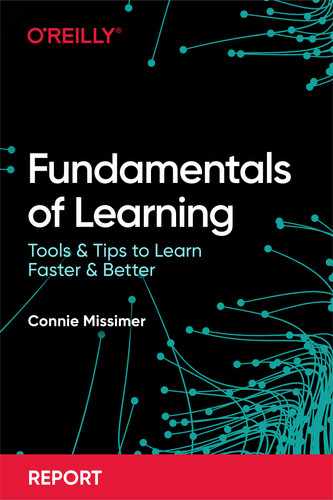Chapter 2. Old Ways, New Learning Styles: Meet Laura, Griselda,
and Your Brain
You may have been struck by how different your usual learning approach is from what the data suggests about best practices. We were all given advice on how to learn from authorities such as history professors (“Defer sleep now, the final is tomorrow!”) or through the osmosis of observation. The differences in today’s techniques are interesting and make learning seem a lot more “natural,” if you will. To help you see the rather stark difference between how many of us have approached learning and what the new data suggests we do, I have cooked up two personas, which I will outline next. After that, we’ll learn some important information from our brain about its mysterious ways.
Griselda and Laura, a Study in Contrasts
Let’s consider the two characters in Table 2-1, one (Griselda) representing what many of us thought was the best way to learn, the other (Laura) contrasting that idea with the latest data, which we covered in Chapter 1.
| Griselda the Grinder | Laura the Lazy |
|---|---|
| Starts at the beginning of the book and takes lots of notes, underlines | Moves from details to the big picture and then back (focused, diffuse thinking) |
| Studies for hours at a stretch | Takes lots of breaks; naps after studying |
| Defers sleep to get in more study | Goofs off, makes unusual associations |
| Focuses on one thing at a time until she feels she has mastered it | Mixes up the study of her subjects (interleaving) |
| Doesn’t ask anybody for help because she feels she should be able to figure things out | Asks herself and her instructor lots of questions; quizzes herself |
| Sticks to the same place and routine | Goes to different places in her apartment to study |
You probably wouldn’t have guessed it before taking the pre-quiz in Chapter 1, but the data shows that Laura the Lazy will learn more easily! She’ll avoid overnighters before a test (as they’re counterproductive), she’ll spend more time quizzing herself than underlining, and she’ll go for the big picture rather than always taking the material step-by-step. Study Table 2-1 for a few moments, because it in many ways is revolutionary. Of course, Laura is not absolutely indolent: she has to quiz herself and, as needed, make those associations. But to a recovering Griselda like me, a lot of it seems like cheating. I had assumed that learning was, at its heart, not fun. In a strange way that’s right, but I’m getting ahead of myself. First I want to offer you a silly sentence that captures all these findings.
The Amazing Power of Mnemonics
If you get anything out of this report, it should be the ability to recall the techniques you’ve been reading about. Mnemonics is the study of ways to remember things, such as through acronyms or alliteration. In thinking about how to best accomplish this, I came up with a bizarre sentence that contains words to remind you of our learning techniques:
I asked for a mixed-up nap break at several Starbucks associations.
Let’s look at how this makes the connections to the best practices we discussed in Chapter 1:
- Ask
-
Quiz yourself.
- Mix
-
Mix up different math problems or artists or sports plays.
- Up
-
Go from focused “up” to diffuse thinking and back (don’t worry, I’ll explain in Chapter 3).
- Nap
-
Self-explanatory—you’ve got this!
- Break
-
Again, you’ve nailed it!
- Several Starbucks
-
Remember to move around to different venues—I’m not endorsing any particular coffee shop, just taking advantage of all those sibilant “s” sounds to help you remember.
- Associations
-
Create as many neuronal connections as you can to ensure you recall the material. This sentence itself is an example of this!
Stare at the sentence for a minute. Then turn your head away and try to recall it. If you’re like me you will remember only a word or two. Don’t worry—I’ll be hounding you throughout this report to recall more of the sentence.
Back to That Crazy Sentence
Speaking of the brain and resistance, can you recall anything about that sentence I just gave you? Take a minute (OK, 15 seconds, who’s counting?) to remember as much as you can. Most people can remember only a word or two at this point. Darn brain!
After you get tired of trying to remember and realize what you don’t recall, you can go review that sentence.
Summary
We saw the contrast between Laura the Lazy and Griselda the Grinder, with the evidence greatly favoring Laura as the better learner. What great news! All those naps and breaks ensure “spaced learning,” just the ticket to help the brain digest what is fed into it. And we saw how the brain treats details like so much confetti, which is why we need to figure out how to get those details into long-term memory. Recent research findings should both reassure us and set us on a less arduous path. Finally, you got that crazy sentence. It will pop up a few more times, along with the request to recall it, along with the explanation. In the next chapter, we’re going to delve into the mysterious focused/diffuse learning strategy as well as the value of quizzing yourself.
